
Apocynaceae is a family of flowering plants that includes trees, shrubs, herbs, stem succulents, and vines, commonly known as the dogbane family, because some taxa were used as dog poison. Members of the family are native to the European, Asian, African, Australian, and American tropics or subtropics, with some temperate members. The former family Asclepiadaceae is considered a subfamily of Apocynaceae and contains 348 genera. A list of Apocynaceae genera may be found here.

Hoodia is a genus of flowering plants in the family Apocynaceae, under the subfamily Asclepiadoideae, native to Southern Africa.

Arillastrum is a monotypic genus of trees in the myrtle family, Myrtaceae, containing the single species Arillastrum gummiferum. It is endemic to southern New Caledonia. It is related to Eucalyptus, but more closely to Angophora and Corymbia.
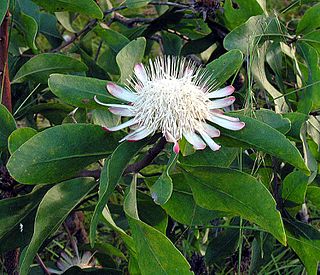
Protea gaguedi is a species of tree which belongs to the genus Protea.

Protea laurifolia, also known as the grey-leaf sugarbush, is a shrub from South Africa. It is native to the Cape Provinces of South Africa.

Hoodia gordonii, also known as Bushman's hat, is a leafless spiny succulent plant supposed to have therapeutic properties in folk medicine. It grows naturally in Botswana, South Africa and Namibia. The species became internationally known and threatened by collectors, after a marketing campaign falsely claimed that it was an appetite suppressant for weight loss. The flowers smell like rotten meat and are pollinated mainly by flies. The indigenous San people of the Namib desert call this plant ǁhoba – and the Afrikaans name ghaap is used to refer to all species of Hoodia.

Hoodia juttae is a species of plant in the family Apocynaceae. It is endemic to Namibia. Its natural habitats are rocky areas and cold desert. H. juttae is found around the Little and Great Karas mountains. It is threatened by collection. The plant was discovered by Jutta Dinter, the wife of botanist, Kurt Dinter in 1913. The scientific name refers to Jutta.

Hoodia ruschii is a species of stem succulent plant in the family Apocynaceae. It is endemic to Namibia. Its natural habitats are rocky areas and cold desert.

Serruria florida is a species of flowering plant in the family Proteaceae, endemic to South Africa. It is known by the common names of blushing bride or pride of Franschhoek.

Melaleuca ericifolia, commonly known as swamp paperbark, is a plant in the myrtle family, Myrtaceae and the genus Melaleuca, native to south-eastern Australia. It is a rather variable species and some specimens resemble Melaleuca armillaris but its papery bark and smaller, more prolific flower heads distinguish it from that species. It often grows in swampy areas and the draining and clearing of these has reduced the numbers of the species, especially around Port Philip Bay near Melbourne. It is also similar to Melaleuca pustulata, a Tasmanian endemic, but that species only grows in dry heath.

Stenocarpus cryptocarpus, commonly known as the giant-leaved stenocarpus, is a species of flowering plant in the family Proteaceae and is endemic to north Queensland. It is a tree with buttress roots at the base, simple, mostly elliptical adult leaves, groups of cream-coloured flowers and narrow oblong follicles.
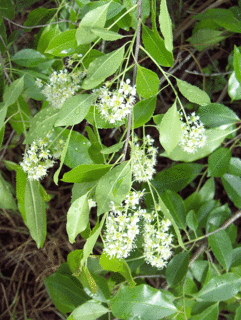
Prunus caroliniana, known as the Carolina laurelcherry, Carolina cherry laurel, cherry laurel, or Carolina cherry, is a small evergreen flowering tree native to the lowlands of Southeastern United States, from North Carolina south to Florida and westward to central Texas. The species has also escaped into the wild in a few places in California.

Lespedeza cuneata is a species of flowering plant in the legume family known by the common names Chinese bushclover and sericea lespedeza, or just sericea. It is native to Asia and eastern Australia and it is present elsewhere as an introduced species and sometimes an invasive plant.
Hoodia flava is a succulent native to the Cape Province in South Africa and to Namibia. It has a unique pattern of distribution, growing inside bushes or on gravelly slopes and hills. It is commonly known as ghaap or yellow-flowered ghaap in the Afrikaans language.

Adenia globosa is a species of flowering plant in the passionflower family, Passifloraceae. It is native to tropical Africa, where it occurs in Ethiopia, Kenya, Somalia, and Tanzania. It is known as mpaga in Swahili.

Iris boissieri, is a species in the genus Iris, it is also in the subgenus Xiphium. It is from Europe, mainly Spain and Portugal. It has blue-purple flowers with a yellow beard.
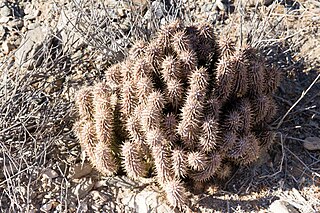
Hoodia alstonii is a succulent plant native to Namibia and the Cape Province of South Africa. H. alstonii is also known commonly as ghaap, an Afrikaans name. It tends to grow in rocky, desert areas.

Hoodia officinalis is a succulent plant native to Namibia and the Cape Province of South Africa. H. officinalis has two officially recognized subspecies, H. officinalis subsp. officinalis and subsp. delaetiana, which are identified mainly by their distribution. Subsp. delaetiana grows only in the Klinghardt Mountains and are larger than subsp. officinalis.
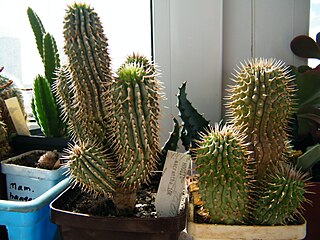
Hoodia macrantha is a succulent plant native to Namibia and the Cape Province of South Africa. It is regarded by some sources as a synonym of the accepted name for the plant, Hoodia currorii subsp. currorii.
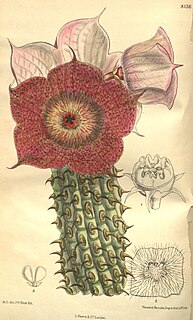
Hoodia currorii is a succulent plant native to Namibia and the Cape Province of South Africa. It grows in desert areas and is common along the road from Karibib to Swakopmund in Namibia. It is also known as ghaap in the vernacular.


















